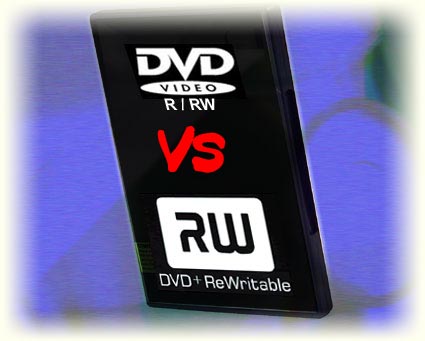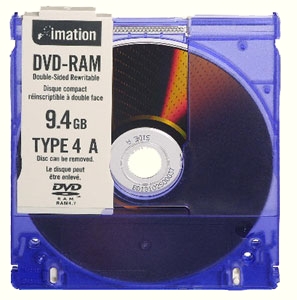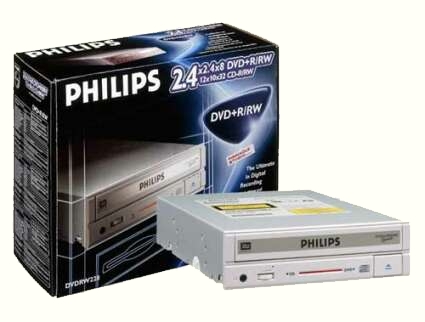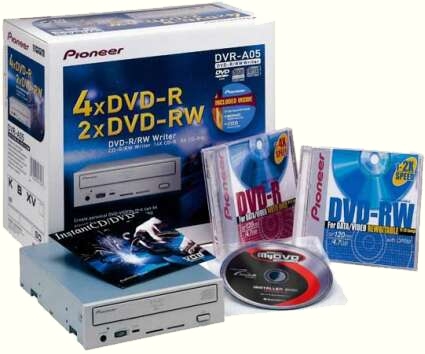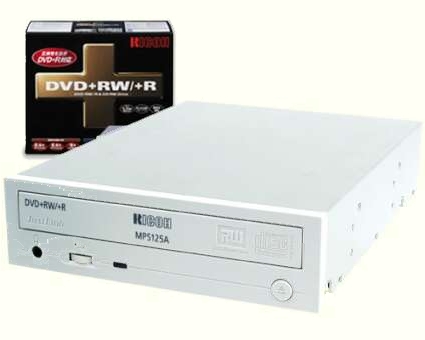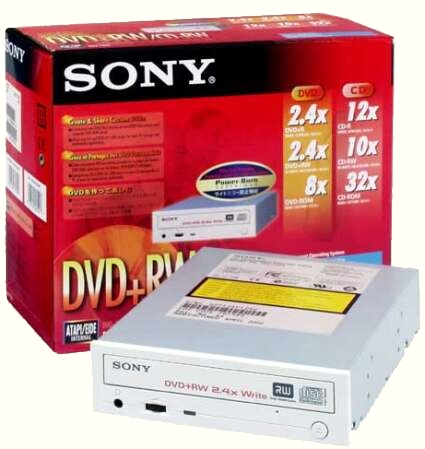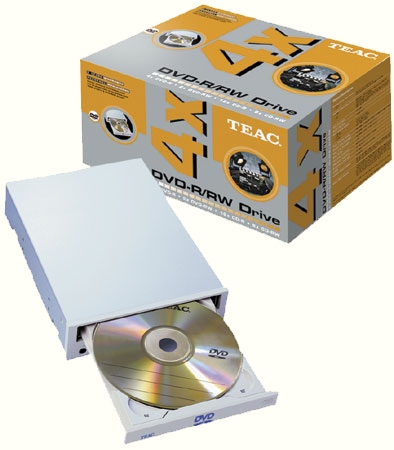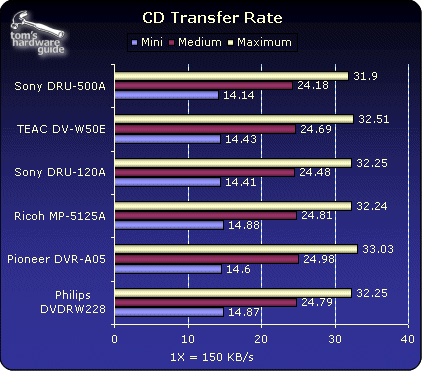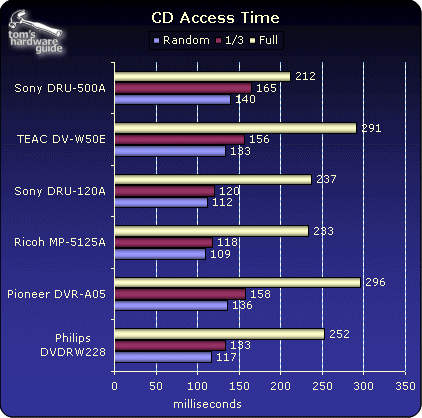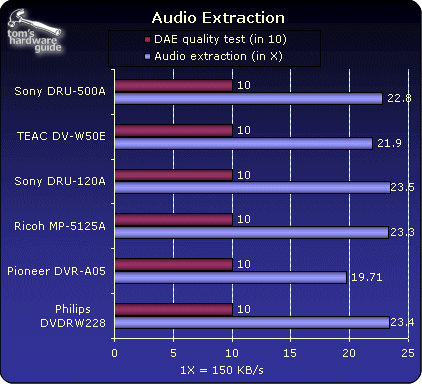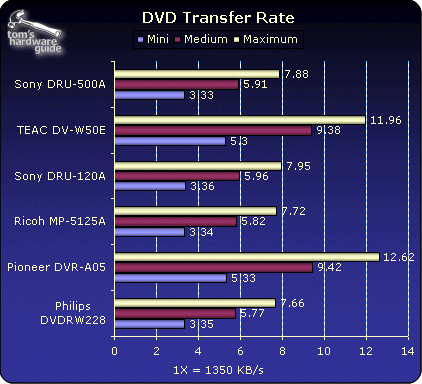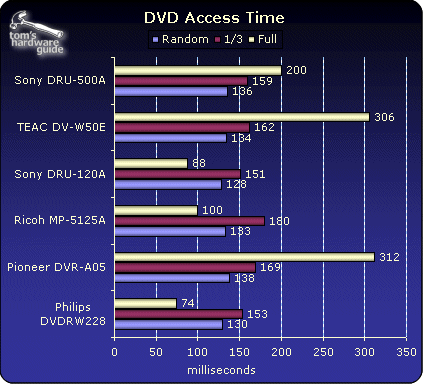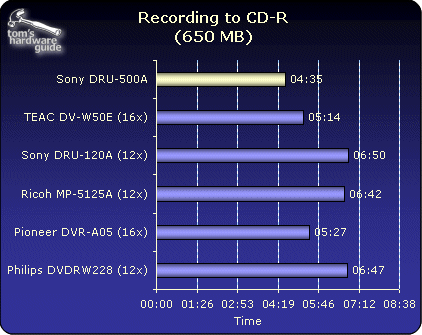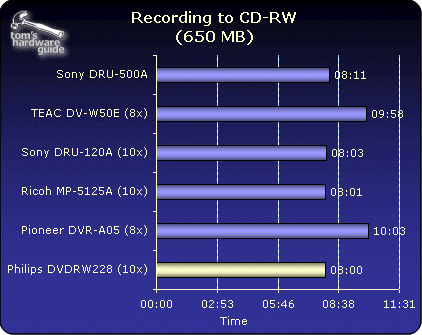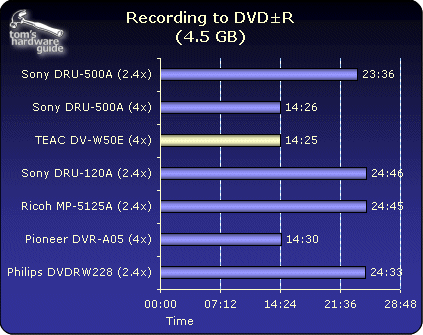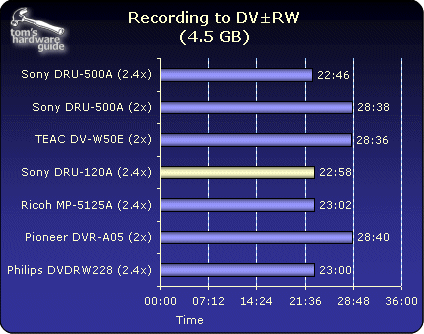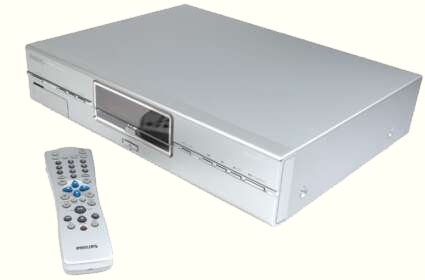 |
|
| DVD Burner Test: Seven Times The Capacity |
|
CD burners can now run at the mind-blowing speed of 52X. An 80-minute CD-R takes under three minutes to burn and a CD-RW no more than five. The technology has reached its zenith and no manufacturer can take it any further without a considerable outlay in research and development to gain a just handful of seconds. Speed is obviously no longer the main requirement, what users want is more storage space. And this is where the DVD comes in!
Seven Times the Capacity Though the CD created a storage revolution in its time, it has now become commonplace. Its 640 MB capacity has become a bit limiting, so much so that most makers only offer 80-minute blank CD-Rs with 700 MB. So the DVD is the answer to the big storage requirements that hard disks of 60, 80 or 120 GB now entail. DVDs have a nominal capacity of 4.7 GB, so in practice you can record just a bit under 4.5 GB. Such high capacity also implies new applications. While the CD was intended mainly for music with very little video, the DVD is really designed for digital video and multi-channel sound. Since it hit the market a few years ago, the public has always known it to be ideal for video, so it is now quite natural for it to be presented as the storage medium for home movies that are usually filmed with digital camcorders. But in addition to video, there are now a lot more audio DVDs around. These provide sound with a better sampling rate, so the quality is higher and sounds much more like the original. DVD audio can also reproduce multi-channel music tracks. We ran tests on the following six DVD burners:
Range of Available Standards When the CD-R was launched, it only came in one version, whereas the DVD comes in three recording formats: DVD-RW, DVD+RW and DVD-RAM. The last of these was developed over ten years ago and is mainly designed to be a professional storage medium. They come in the form of cartridges that are inserted into the burner. This, of course, is a format incompatible with DVD-ROM drives, and even less so with home players, so it's on its way out, to be replaced by the other two formats: DVD-RW and DVD+RW. On the one hand, we have the forerunner Pioneer, who, in
accordance with DVD Forum (the entity which controls the DVD name
and technical aspects), developed the DVD-RW.
DVD+RW On the other hand, there is DVD+RW Alliance, where,
among others, we find HP, Philips, Ricoh, Sony, Thomson and Yamaha. They
officially claim to have developed a new format because the DVD-RW cannot handle
video recording very easily. But it may be that they just don't want to pay
royalties to DVD Forum.
The Differences There is very little difference between DVD-R and DVD+R, both of which can only be written once. They are used in exactly the same way. But you have to be careful with DVD-R because there are two standards for blank disks. The one to use is marked "DVD-R for General Use." The other is marked "DVD-R for Authoring," and it only works for mastering DVD video or data because its composition is different. This sort of DVD-R is not usually available to the general public. Things get a bit more complicated with DVD-RW and DVD+RW. DVD-RW technology is very similar to that of the CD-RW. For DVD+RW, the Alliance wanted to make video recording easier, especially for home use. So they implemented a technology called Lossless Linking. In DVD+RW video format, a video can be encoded in VBR (variable bit rate). The process of writing at a constant rate takes up a lot of room, so it has to be stopped and started again. This is likely to cause link loss, which makes the disk incompatible with read-only devices like DVD video players. With DVD+RW, the process can be stopped and started again without any link loss. This characteristic makes the format efficient and suitable for random data writing and video applications. With lossless linking, it is also possible to replace any individual block of 32 KB (write unit) with another, without losing compatibility. For a lossless link, each block of data must be written in the right place with precision (on 1 micron). For this, the groove is controlled by a high-frequency wobble (817 kHz at n=1) to ensure that writing stops and starts in an exact position. The writing clock resulting from the groove is very precise. At the same time, addressing information is stored in the spiral groove by locally inverting the radial wobble mark. There are four addresses per ECC block of 32 KB, so the address format is reliable with wide margins of detection. The Drives Philips DVDRW228
Philips was the first manufacturer to design a DVD burner that was compatible with the DVD+RW standard - the DVDRW208, which we had looked at previously. This model could only burn DVD+RWs, not DVD+Rs. Now, the DVDRW228 has put this straight. As for the rest, the specifications could not be more standard. Write speed in +R and +RW mode is 2.4x, i.e. 3300 KB/s. The burner's design is not so standard. On the front is a large indicator which changes from blue, for play, to red, for write. Two other LEDs show when the burner is in CD or DVD mode. For CD burning, the DVDRW228 has the usual range of protection mechanisms against write errors. There is the Seamless Link Buffer Underrun Protection, which protects the recording from shortages of information arising from empty buffer memory. Then there is the Thermo-Balanced Writing, which analyzes the quality of the blank support and automatically adjusts write speed and laser strength. Software Package The software comes complete with applications for burning, video editing and authoring. The package includes Ahead Nero Burning ROM 5.5, Ahead InCD, PowerDVD, Sonic MyDVD and Pinnacle Studio 7 for video editing. There is also an excellent installation guide that comes in the form of a step-by-step video. Pioneer DVR-A05
It's now one and a half years since Pioneer brought out the first DVD burner for the general public. The DVR-A03 was the first to make burned DVDs compatible with home players. It did have some teething troubles, such as random DVD-RW recording. Pioneer corrected this with the DVR-A04, but added nothing in the way of speed. This has now been rectified by the DVR-A05 (OEM version) and DVR-105 (own version). These two are the fastest burners on the market at 4x, i.e., 5.54 MB/s in DVD-R mode and 2x (2.77 MB/s) in DVD-RW mode. Software Package The package contains two programs: Instant CD/DVD for burning, and Sonic MyDVD for authoring. They could have included a video editing program, though this is often provided with acquisition cards. Beware of Killer DVD-RWs! Burning with the DVR-A05 at 4x (DVD-R mode) and 2x (DVD-RW mode) requires high speed blanks. If you were to use these on the older Pioneer burners - the DVR-A03 (or DVR-103) and DVR-A04 (or DVR-104) - you risk damaging them. To prevent this, you have to update the burner Firmware. Updates for Pioneer DVR-A03 or DRV-103 are available here. Updating the burner also means that recording speed in DVD-RW mode goes up, from 1x to 2x. And for once there's no charge, so go right ahead! Ricoh MP-5125A
Ricoh, another major partner in the DVD+RW Alliance, is now offering the MP-5125A. This is the successor to the MP-5120A (only DVD+RW), and it has technical features similar to those of its +RW stablemates. Its maximum speed in +R and +RW is 2.4x, and its outer appearance is extremely classic. Software Package Apart from Ahead, Nero Burning ROM 5.5 and InCD, the package contains some less common applications. For recording and video retouching it has WinProducer, and WinDVD for playing. The big surprise comes from Neo DVD, which is incredibly easy to use. Once the digital camcorder or other video source is connected, all you have to do is press one button to start burning the DVD directly. This saves a lot of time if you just want to free up your cassette and store the video on it for later editing. But you can also edit videos and label your video sequences in no time. Sony DRU-120A
Like the rest of the DVD+RW family, the Sony DRU-120A is the successor to a model that could only burn DVD+RW (the Sony DRU-110A). Like its mates, this burner can record DVD+R and +RW at 2.4x. The front panel design is identical (apart from the logos) to that of the Ricoh. Sony uses a Ricoh mechanical basis, though its firmware versions are different. Software Package As with its CD-RW burners, Sony includes the B's, Recorder Gold and CliP software in its package. Unlike its rivals, it innovates by adding Retrospect Express backup software. It has PowerDVD for DVD play, along with the excellent Neo DVD (see Ricoh MP-5125A, above) and MusicMatch Jukebox. TEAC DV-W50E
TEAC, a major player in the burner world, has introduced its first DVD burner. It has opted for compliance with DVD Forum's specifications, and uses the DVD-R/RW format. Its characteristics are exactly the same as those of the Pioneer burner. Burn speed in DVD-R mode is 4x, 2x in DVD-RW mode. Software Package The TEAC comes with just two programs: Nero Burning ROM 5.5 for burning, and Studio 8 for video editing. Studio 8 is the excellent Pinnacle program that you can also use to author your DVDs. Sony DRU-500A
Sony is the first manufacturer to produce a DVD burner that is compatible with both the DVD-RW and the DVD+RW standards. Though it belongs to the DVD+RW Alliance, Sony has opted for a combined burner. The DRU-500A is therefore at the top of the range. The burner has adopted the highest performance of each standard, so its technical characteristics are impressive: in minus mode, it burns at 4x and rewrites (DVD-RW) at 2x. Nothing new for the plus mode, where writing and rewriting are done at 2x; but when it comes to CD burning, the DRU-500A stands apart from its rivals. It burns a CD-R at 24x and a CD-RW at 10x. It also has a buffer memory of 8 MB. Software Package Sony provides the same package as for the DRU-120A. This includes B's Clip, B's Recorder Gold and PowerDVD. There is also an external version of the universal burner - the DRX-500UL with a FireWire interface and USB 2.0. Test Setup and Methods The tests were run in four stages:
We ran all the tests on blank Imation disks and thereby ensured
equal quality of the disks and fairness in testing.
CD Playback Tests
DVD Playback
Conclusion You will notice that all the burners in the tests are pretty much equal. Though some models did better in some tests, the differences are minimal for both read and write. We can't even distinguish by price, since the recommended price for each of them is around $300. But we can differentiate two categories of use. Archiving If your main goal is to archive data, the DVD-R format (Pioneer DVR-A05 or TEAC DV-W50E) is the best choice. 4x burn speed gives you your result in 15 minutes. The time saved compared to DVD+R at 2.4x (over 24 minutes) is not to be sneezed at. Video However, if you are more interested in video, the DVD+RW format is still the best solution. It is much more flexible to use and, what's more, it is compatible with Philips home players. Now About Sony With the DRU-500A, the question of utilization is irrelevant. Because it is universal, you can let your needs decide your choice. Of course, it is more expensive than the others at $350 for the internal version and $430 for the external one. But the price difference is not, after all, the end of the world!
Compatibility In the end, apart from certain technical differences between the two formats which prevent you from using a DVD+RW disk on a DVD-RW burner and vice versa, the final recorded disk (DVD-RW or DVD+RW) is read-compatible with DVD-ROM drives, home players and even DVD-RW or DVD+RW burners. Most of the branded home DVD players released within the last two months are not just DVD-RW- or DVD+RW-compatible, they are also DVD-R- and DVD+R-compatible. For older players, the compatibility rate is 80%. Blank Disks Never has the quality of blank disks been more important. No-name disks from Asia may cut prices, but above all, they cut quality. DVD recording absolutely must be done on good quality disks, and this means branded ones. | ||||||||||||||||||||||||||||||||||||||||||||||||||||||||||||||||||||||||||||||||||||||||||||||||||||||||||||||||||||||||||||||||||||||||||||||||||||||||||||||
